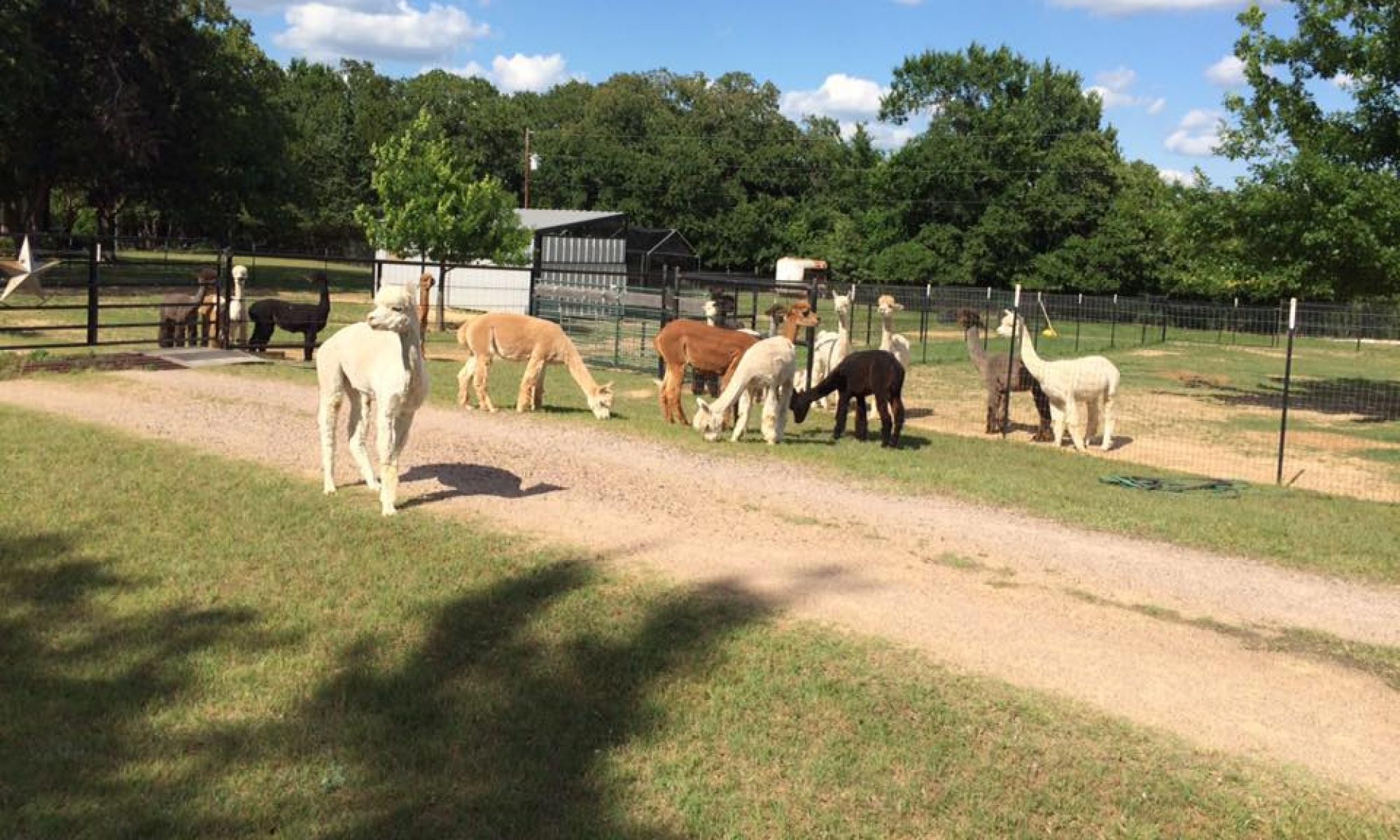Frequently Asked Questions About Alpacas…
- Why Alpacas?
- How are Alpacas different from Llamas?
- What are these animals raised for? Do they taste like chicken? Are they expensive?
- Are Alpacas dangerous?
- How are Alpacas transported?
- Are there different kinds of Alpacas?
- How much land does it take to raise Alpacas?
- How easy is it to care for Alpacas?
- What type of food do Alpacas eat?
- Do Alpacas spit?
- What is the life expectancy of an Alpaca?
- How long is their gestation?
- Can I pet them? (Our most often asked question…)
- How can I learn more about them?


Q: Why Alpacas?!
A: Ask any Alpaca rancher and they will tell you the same thing: “There’s something magical about these creatures.” Couple that with the knowledge that Alpaca breeding can be a very lucrative business, appealing to people of all ages and from all walks of life, is it any wonder that the popularity of Alpaca ranching has seen a dramatic increase in the past decade?
Q: How are Alpacas different from Llamas?
A: Even though they are both from the camel family, i.e., “camelids,” they have certain differences, The Alpaca’s overall height are shorter than that of a Llama; and an Alpaca’s ears don’t make that banana-shaped curve in toward the middle like a Llama’s does. Alpacas tend to be more of a herd animal, whereas Llamas can be a little more solitary. Since Llamas are larger, they can defend themselves better against coyotes and dogs, so sometimes they are used as guard animals with Alpacas. Llamas are used primarily in South America as pack animals, while Alpacas are raised everywhere for their fleece, which leads to the next question…
Q: What are these animals raised for? Do they taste like chicken? Are they expensive?
A: Alright, we know that’s three questions, but they are all related. Alpacas are raised for their fabulous fleece, which is very much like cashmere—a fiber obtained from Cashmere and other types of goats. Alpaca fleece is hypoallergenic and comes in 18 different natural colors. It is used to make things like sweaters, jackets, gloves, baby booties, baby blankets, pillows, throws, rugs and even teddy bears and other toys or gift items! Many Alpaca owners sell their animals along with their raw fiber and finished goods—like Aubrey Oaks Alpacas does. These sales can generate nice receipts to provide an ongoing income stream.
The fact that the registry of Alpacas in North American (through A.R.I.) has been closed since 1998 makes them more valuable to both ranchers and prospective owners alike. But, as with any commodity, prices are affected by our economy in general. For the most part, as our nation’s economy has faltered through the end of this last decade and the beginning of the current one, prices of Alpacas have become more affordable. (But please, don’t consider buying one from the sale barn or from an uninvestigated source!) One of the reasons that we have chosen to raise Alpacas is that right now, here in the U.S., they generally are not eaten. You would have to travel to Peru, Argentina, Bolivia or Chile to find out how one would taste.
Q: Are Alpacas dangerous?
A: They are not dangerous if you use wisdom in handling them. They do not have sharp front teeth, horns, or claws that would make them dangerous. The only thing that they can do is kick with their hind legs, buy they don’t kick hard enough to cause any severe damage—although bruises can happen. Knowing which ones are prone to kick and not providing them the opportunity to kick you is key. Alpacas eyes are on the side of their head so they can’t see anything directly behind or in front of them. Because of this, Alpacas may become frightened and kick when approached from behind.)
Most mature males will always have razor sharp fighting teeth—but these are used against other males as they live up their name in their male-to-male herd dominance encounters. Sometimes you may see a male with a scissored ear, or even find that a male in the herd has been castrated by another male. This is rare as fighting teeth are to be kept trimmed by responsible owners. But Alpacas generally don’t hurt a human—unless you get your finger in the wrong place when trimming those teeth! (We use a dog chew to keep their mouths open as the occasion is needed, and then use tin snips to trim the points off the top of those teeth. There are power tools made specifically for fighting and front teeth trimming.)
Q: How are Alpacas transported?
A: For short distances, Alpacas can be transported in a mini-van, in the back of a regular size van, or even in the back seat of a pickup truck. As the vehicle starts to move, Alpacas will “cush” (sit down.) We own a 16′ stock trailer which we use to transport them. This includes transporting them to the vet or to one of the several Alpaca shows that are in Texas and the surrounding states.
Q: Are there different kinds of Alpacas?
A: Yes, there are two types. Suri (pronounced sir’-ee) Alpacas have long twisted locks that lay somewhat flat on their bodies. They stream in an elegant manner when a Suri runs. Aubrey Oaks Alpacas raises Huacaya (pronounced wah-kay’-ya) Alpacas which are cute & fluffy when their fleece grows long through the fall and into the winter months. There are over 8,000,000 Alpacas in South America with Huacaya in the majority. There are also over 150,000 (nearing 200,000) registered Suri & Huacaya Alpacas here in the U.S. Huacaya outnumber Suri on the more than 4,000 ranches here in the U.S. The first ones were brought here in the 1980’s Importation of Alpacas into the United States (that can be registered with A.R.I.) has been closed since 1998.
Q: How much land does it take to raise Alpacas?
A: You can place 5 to 10 Alpacas on an acre of land, depending upon the way that the land holds rain/snowfall, the terrain and the quality of the pasture. Alpacas are very easy on the land. They have padded feet so they don’t tear up the soil. Having only lower teeth and a strong upper dental pad, they don’t pull the grass up from the root, nor do they graze it all the way to the ground like a horse does. They can also be raised on a dry lot and fed only hay. Their unique barnyard habits make them desirable for “urban ranching.” Alpacas are like a cat in that they always go to one or two places in the pasture to “do their business,” thus making pasture clean-up a relative breeze.
Q: How easy is it to care for Alpacas?
A: They are very easy to maintain. They need to have basic shelter from heat and foul weather. They will not challenge fences, but adequate fencing with a small weave (2″ x 4″) is needed to keep predators out if they are in your area. Being livestock, they do require regular vaccinations, and they need to be on an anti-parasite control program. Their toenails need to be trimmed every month or so, and their teeth may need trimming occasionally. Monthly herd health days to accomplish our regular monthly duties take just a few hours for our herd. Finally, they need to be sheared annually so that they don’t get too hot in the summer time.
Q: What type of food do Alpacas eat?
A: They primarily like to graze pasture but also eat hay. Alfalfa hay is not normally utilized here at Aubrey Oaks, but some owners feed it to them sparingly. We will use it for a dam that is nursing. Orchard Grass hay imported to Texas from Colorado is our favored hay. One to one-and-a-half 60-pound square bales of hay will usually feed 20 to 25 Alpacas a day. We have found that 10 small square bales lasts about 12 weeks for 6 Alpacas during the summertime.
Most owners do feed their Alpacas a type of grain supplement. Most of the grain that is fed to the Alpacas is used as a nutritional supplement and can also be used as a reward for those ranches that train their Alpacas. Even these foods are regulated based upon our frequent body scoring. On a scale of 1 being emaciated and 10 being obese, we try to keep our animals around a 5.
Q: Do Alpacas spit?
A: Alpacas are members of the camel family and can spit. About the only time that our female Alpacas spit is when they are eating at a trough. The spit at each other as a result of territorial issues. Males on the other hand more frequently spit at each other to establish herd dominance. Males especially will also neck-wrestle, chest-butt or chase and scream and bite at each other. It is very rare that our males or females spit on us. Most of the time that humans are spit on is when they get caught in the crossfire of Alpacas spitting at each other. We owned ours for over 6 months before getting nailed in the face with a large gift of spit. 🙂 With time, even the least experienced Alpaca owner can begin to recognize the tale-tell sounds and actions of their herd and learn to avoid it.
Q: What is the life expectancy of an Alpaca?
A: We are not really sure how long the Alpacas can live here in the US. They haven’t been here long enough for adequate information to be collected. Information from South America indicates that they can live 15-25 years. We pamper our Alpacas with manicured & fertilized fields, shade, sheds or barns, water, electrolytes, fans, shots, probiotics and appropriate feed so we have high hopes that they will live that long or longer here! Unfortunately, South America experiences about a 30% cria mortality rate due to lack of shelter during bad weather.
Q: How long is their gestation?
A: Females carry their pregnancy for about 11½ months. Average gestation is somewhat shorter for fall births and longer for spring births. They have the ability to put their delivery off when they experience stress, and deliveries at 13-14 moths have been reported.
Q: Can I pet them? (Our most often asked question…)
A: Alpacas are generally considered livestock, not “pets” So let’s talk about the issue of “petting” them… First off, you will have better chances getting a “nose kiss” from an Alpacas than them allowing themselves to be touched. Also, Alpacas generally don’t respond to being called by name like a dog would, although there are some owners that assert that they’ve trained them to respond! In our eyes, they are more like a cat—they will almost always come to you at feeding time; and though curious, will just as easily walk away from you if they set their minds to it. (They learn the sounds of feed time, whether a metal trash can lid that holds the feed, or a shed door opening.
Most of the time Alpacas that have been raised correctly should allow you to touch them in passing, but they don’t normally stand still to be petted—especially if you are new to them. That being said, here at Aubrey Oaks Alpacas, we try to put our hands on our Alpacas as much as we can without trying to make them a “pet.” Each Alpaca has their own personality, and some will take to being touched more than others. Certain Alpacas personalities change if stressed, scared, expecting or lactating. And, of course, there are generally different expectations for males & females. (But that’s another story…)
Feeding time in the evenings make them relatively easy to catch as you can entice them into a catch pen with their food. And, if haltered, most will stand still for “inspection,” but they can just as quickly buck or tug on the lead, or cush (sit down). Taking them to show means that we do attempt to train our Alpacas to stand still, as this is what they do most of the time in a competitive show. Aubrey Oaks Alpaca Ranch is definitely not a petting zoo, but is a working ranch. Can you own them as a pet? Sure—with a minimum of two—herd animals don’t do well by themselves! Just don’t expect to get a 150 lb. “lap” Alpaca!
Q: How can I learn more about them?
A: Websites are wonderful for conceptual learning. But, our herd health Saturdays are monthly events that can give you greater insight into the joys of working with Alpacas. For the serious-minded enthusiast that is considering the Alpaca lifestyle, these “work” days are an excellent way to learn about what it takes to properly & responsibly raise these beautiful animals. See our NEWS webpage (or message or call us!) to learn how you might be able to visit us during one of these days! (Of course, we do reserve the right to determine who would be qualified to visit our ranch during these busy days.)
If herd health days don’t work for you, but you want to learn how to own & raise Alpacas, call us and we will make every effort to accommodate your visit to our ranch. If you just want to see them up close, plan to visit the spring or fall events at Lavender Ridge Farms.

